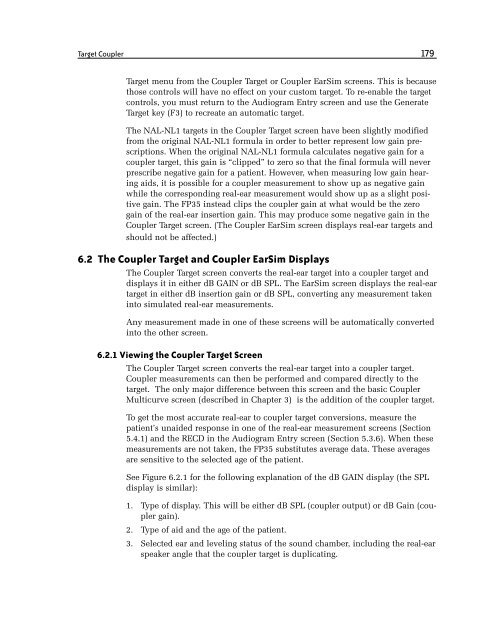FONIX® FP35 Touch - Frye Electronics
FONIX® FP35 Touch - Frye Electronics
FONIX® FP35 Touch - Frye Electronics
Create successful ePaper yourself
Turn your PDF publications into a flip-book with our unique Google optimized e-Paper software.
Target Coupler 179<br />
Target menu from the Coupler Target or Coupler EarSim screens. This is because<br />
those controls will have no effect on your custom target. To re-enable the target<br />
controls, you must return to the Audiogram Entry screen and use the Generate<br />
Target key (F3) to recreate an automatic target.<br />
The NAL-NL1 targets in the Coupler Target screen have been slightly modified<br />
from the original NAL-NL1 formula in order to better represent low gain prescriptions.<br />
When the original NAL-NL1 formula calculates negative gain for a<br />
coupler target, this gain is “clipped” to zero so that the final formula will never<br />
prescribe negative gain for a patient. However, when measuring low gain hearing<br />
aids, it is possible for a coupler measurement to show up as negative gain<br />
while the corresponding real-ear measurement would show up as a slight positive<br />
gain. The <strong>FP35</strong> instead clips the coupler gain at what would be the zero<br />
gain of the real-ear insertion gain. This may produce some negative gain in the<br />
Coupler Target screen. (The Coupler EarSim screen displays real-ear targets and<br />
should not be affected.)<br />
6.2 The Coupler Target and Coupler EarSim Displays<br />
The Coupler Target screen converts the real-ear target into a coupler target and<br />
displays it in either dB GAIN or dB SPL. The EarSim screen displays the real-ear<br />
target in either dB insertion gain or dB SPL, converting any measurement taken<br />
into simulated real-ear measurements.<br />
Any measurement made in one of these screens will be automatically converted<br />
into the other screen.<br />
6.2.1 Viewing the Coupler Target Screen<br />
The Coupler Target screen converts the real-ear target into a coupler target.<br />
Coupler measurements can then be performed and compared directly to the<br />
target. The only major difference between this screen and the basic Coupler<br />
Multicurve screen (described in Chapter 3) is the addition of the coupler target.<br />
To get the most accurate real-ear to coupler target conversions, measure the<br />
patient’s unaided response in one of the real-ear measurement screens (Section<br />
5.4.1) and the RECD in the Audiogram Entry screen (Section 5.3.6). When these<br />
measurements are not taken, the <strong>FP35</strong> substitutes average data. These averages<br />
are sensitive to the selected age of the patient.<br />
See Figure 6.2.1 for the following explanation of the dB GAIN display (the SPL<br />
display is similar):<br />
1. Type of display. This will be either dB SPL (coupler output) or dB Gain (coupler<br />
gain).<br />
2. Type of aid and the age of the patient.<br />
3. Selected ear and leveling status of the sound chamber, including the real-ear<br />
speaker angle that the coupler target is duplicating.
















